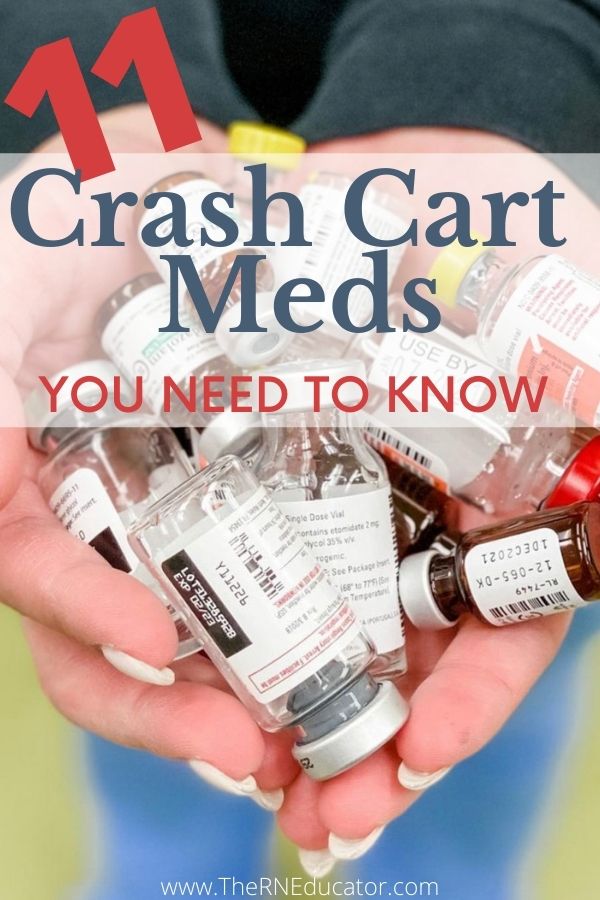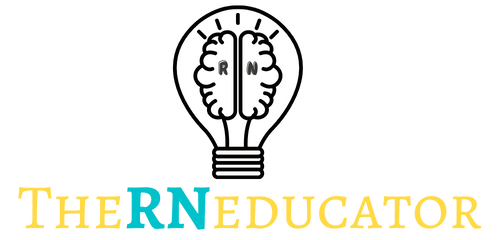11 Crash Cart Meds You Need to Know

Have you ever been in an emergency situation and looked into the crash cart thinking “WHAT. THE. HECK. IS. ALL. THIS?!” Well, I’ve got news for you, most new nurses are very overwhelmed when using the crash cart, giving crash cart meds and some don’t even know half the stuff that is actually IN one (unless they use it often, of course). It’s true!
As a Nurse Supervisor, one of the things I would help all the new pediatric nurses with on my floor was to make sure they felt comfortable with the crash cart and it’s components, ESPECIALLY crash cart meds. It is something I truly do feel needs to be reviewed more frequently than it is. This is why today I want to focus on reviewing the very first drawer of the PEDIATRIC crash cart. The drawer that houses all crash cart meds. The Medication Drawer!
**Keep in mind – although this post focuses on the Pediatric Crash Cart all of these medications are found in an Adult crash cart as well however, may be used differently and with different doses.
What is ‘The Medication Drawer’ and what’s in it?
Well, it’s quite simple and exactly what the name suggest! It’s where all crash cart meds reside. Think any medication that needs to be given for cardiac arrest, code blue scenarios, intubation, anaphylaxis, arrhythmias and more. We will be going into more detail with each of these crash cart meds, what they are, what they are used for, some potential side effects, and some nursing tips to always remember.
1. Epinephrine
Epinephrine is the primary medication that is used in the crash cart. During a code blue, Epinephrine or Epi is used in many situations where you need to restart the heart, improve heart muscle contractility, and increase cardiac output. Situations such as Pulseless Electrical Activity (PEA), asystole, V-fib, pulseless V-tach, anaphylaxis, and status asthmatics, are just a few of many issues Epi can fix.
Side effects of Epinephrine include hypertension, nervousness, restlessness, tachycardia, and even chest pain. Continuous cardiac monitoring must be performed before, during and after Epinephrine has been administered.
There are two different concentrations for Epinephrine and you must carefully verify this when drawing up a dose for administration. Epinephrine 1:10,000 is the dose that is commonly used for cardiac arrest and asystole while Epinephrine 1:1000 is used for anaphylaxis. It is VERY important to never confuse the two.
Note: Epinephrine 1:1000 can ONLY be giving intramuscularly due to its high concentration and risk of serious arrhythmia if given IV.
2. Amiodarone
Amiodarone is a medication used to treat ventricular fibrillation and ventricular tachycardia. This medication is in the crash cart although according to the ACLS, primary treatment of V-tach and V-fib are epinephrine and vasopressin.
When giving Amiodarone, keep in mind, due to its vasodilator effects, continue monitoring heart rate and blood pressure as these can drop leading to serious hypotension.
3. Atropine
Atropine is given in situations where heart rate has dropped to very dangerously low levels such as in symptomatic bradycardia. Atropine helps by speeding up the heart rate. Therefore, it is contraindicated to give to patients who have tachycardia or glaucoma.
4. Calcium Gluconate
Calcium Gluconate is used in patients experiencing hyperkalemia, calcium channel blocker overdose, as an anti-dote to hypermagnesemia, and for patients with hypocalcemia. It is very important you monitor and review your patients electrolyte levels prior to and after administration.
A serious contraindication includes patients with V-fib, digitalis toxicity and hypercalcemia. Ensure a patent and adequately placed intravenous access is available (can only be given IV/IO) as infiltration can cause necrosis.
Note: Calcium Gluconate and Calcium Chloride precipitate when mixed with Sodium Bicarb, therefore, always make sure to flush line thoroughly and not mix the two drugs.
5. Sodium Bicarbonate
Another crash cart med that is important to know is Sodium Bicarb. Sodium bicarb is used in patients who have metabolic acidosis during cardiac arrest or hyperkalemia. This drug buffers metabolic acidosis and lactic acid and helps stabilize patient and seize further coding. Therefore, a contraindication would be respiratory or metabolic alkalosis or hypokalemia.
Be aware of the concentration of the Sodium Bicarb in your crash cart. As of 2020, it is recommended for children doses to be diluted to a Sodium Bicarb concentration of 4.2%.
Note: Ensure IV line is flushed thoroughly before and after administration as many drugs can precipitate when mixed with NaHCO3.
6. Dopamine
Dopamine is a medication used to treat decreased cardiac output that can lead to hypotension. This medication helps vasodilate the vessels and promote increased blood circulation to vital organs such as the heart, brain and kidneys. It is given as a drip in the ICU.
Dopamine is contraindicated on patients with an increased HR or blood pressure. Be sure to verify doses for patients taking MAOI’s as they generally have a smaller dose than the standard.
Note: Extravasation of this medication can cause tissue necrosis. Be sure to assess your IV’s frequently, surrounding skin and verify adequate placement.
7. Naloxone
Naloxone, also known as Narcan, is crucial to include in a crash cart. It is a crash cart med because it serves as an antidote to specific opioids such as morphine, fentanyl and oxycodone codeine. This means the emergency med helps reverse any effects a potential opioid overdose may have caused including CNS and respiratory depression, altered level of consciousness and coma.
Note: Although you think you would give Narcan for all opioid overdoses, use extreme caution in a patient who is narcotic -dependent due to risk of withdrawal symptoms. It is also recommended not to use on neonates who’s mothers were addicted to narcotics during pregnancy as it can also cause severe withdrawal symptoms.
8. Lidocaine
As like Amiodarone, Lidocaine is an anti-arrhythmic that can treat cardiac arrest from V-tach and V-fib. Either medication can be used as per the 2020 ACLS algorithm.
9. Magnesium Sulfate
Mag Sulfate is a medication that helps reduce muscular contractions. This means this medication assists with patients who are having seizures secondary to eclampsia during pregnancy, cardiac arrest from hypomagnesemia or torsades and for status asthmatics patients who are not responding to beta-adrenergic drugs.
Patients should be monitored for respiratory & CNS depression, hypotension, and depressed reflexes when given Magnesium Sulfate. Flushing and sweating may also occur in your patients after administration. This medication should be given slowly and it is recommended it is not given to patients with renal failure or within the 2 hour mark of delivery, however, always follow your hospitals protocols and guidelines.
Note: Always have the antidote for this medication on hand and ready. Do you know the antidote to magnesium sulfate? It’s Calcium Gluconate (or calcium chloride if calcium gluconate is not available)!
10. Adenosine
This antidysrhythmic drug is used to slow down the heart by decreasing electrical conduction. Adenosine is given when a patient has Supraventricular Tachycardia (when vagal maneuvers fail) or Wolff-Parkinson-White (WPW) Syndrome. I talk all about Supraventricular Tachycardia and what to do in this post!
Be aware this crash cart med may cause a few seconds of transient bradycardia or heart block showing a moment of asystole on the monitor (think of it as a reset of the heart). However, because of its short half life this pause is very brief and should put the patient back into a normal sinus rhythm. Make sure to advise the patient, if conscious, the effects of adenosine such as chest discomfort and strange feelings like anxiety.
Note: Adenosine should always be given in an IV line closest to the heart and is administered as a rapid push followed by a rapid flush due to its extremely short half-life of ~10 seconds or less.
11. Dextrose
Dextrose will always be found in your emergency crash cart meds drawer. BE ALERT! Dextrose usually comes in a D50 concentration therefore, would have to be further diluted depending on your order and form of administration. Dextrose is given for severe hypoglycemia, altered level of consciousness and coma.
Contraindications for administration of Dextrose in an emergency situation includes intracranial bleed. Due to dextrose’s potency, it is very important to ensure you have a patent and adequately placed intravenous line on your patient as it can cause extravasation leading to tissue damage.
Note: Remember, D50 must be administered very slowly.

Hope you guys found this post helpful and feel a little more prepared as to what emergency crash cart meds you can find in your crash cart and on your unit. There is nothing like feeling prepared for an emergency situation and I have no doubt after reviewing these you will feel just that!
Ever had an emergency situation where you had to use the crash cart? How was your experience? What medication did you use? Comment below!
Use HIPPA when commenting.
Disclaimer: This information is not intended to replace a nursing school, used as medical advice or replace your hospital’s guidelines or protocols. This information is to be used as supplementary educational content. Keep in mind, due to the ever changing nature of science, the information on this post may become outdated as new research is concluded. Always do your research and follow your hospital or workplace guidelines.
’till next time,
The RN Educator
Share this:
Related Posts
What’s in a Pediatric Crash Cart? Nursing Students read NOW!
A pediatric crash cart is a mobile unit containing essential equipment and medications required for…
Share this:
How to Become a Confident Nurse
If you are anything like me, and let’s face it (like every nurse…




Asystole: to shock or not to shock? - The RN Educator | 22nd Jan 21
[…] the crash cart. The crash cart houses anything you need in an emergency situation. This includes emergency medications, intubation supplies and equipment, defibrillator, suction + oxygen, and other emergency supplies […]